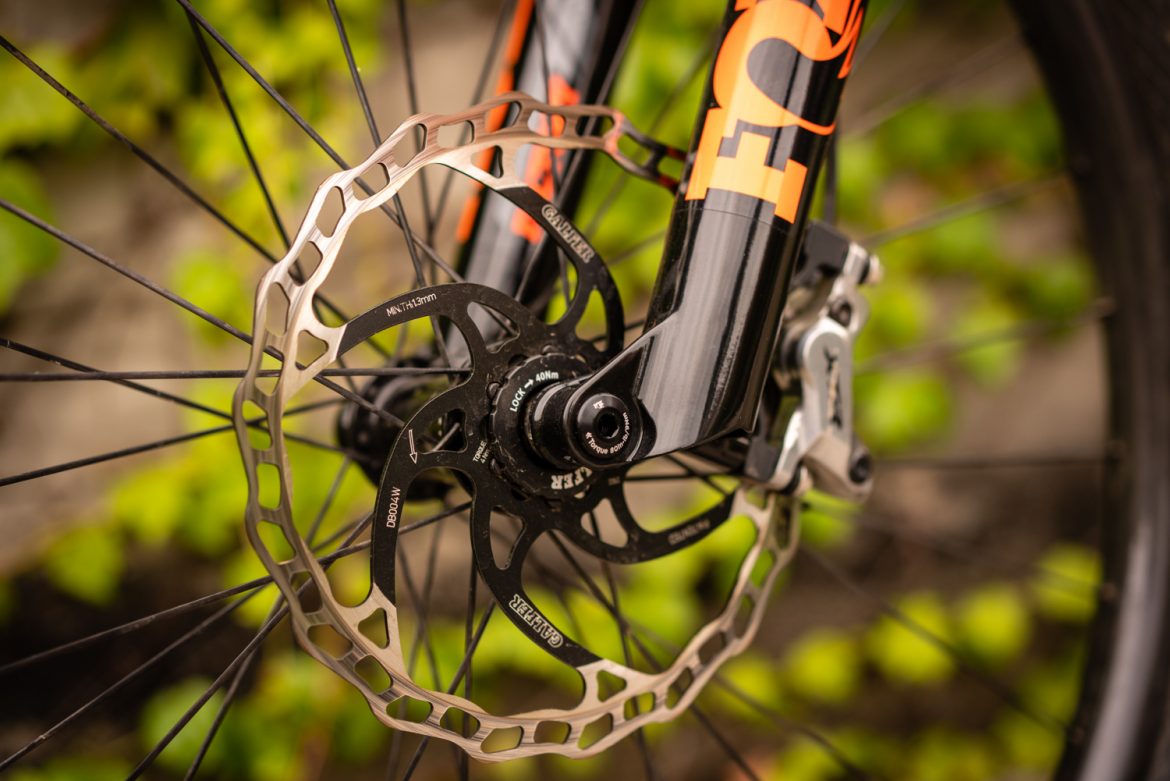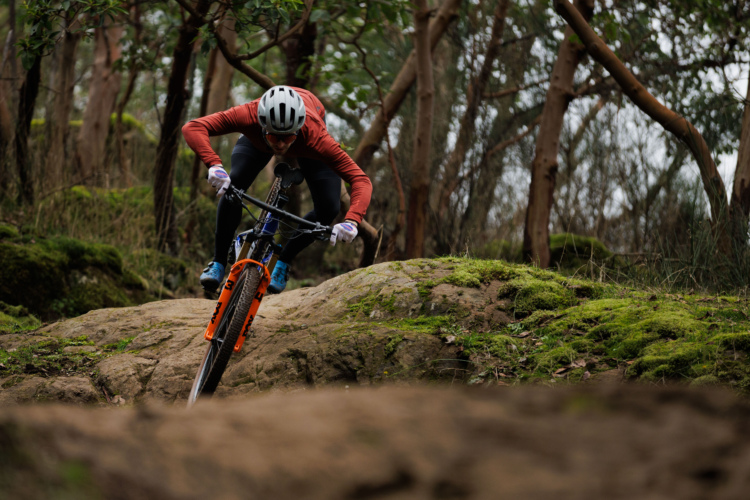
2021 Fox 34 Fork
- Price: $749 – $1,399
- Buy from Jenson USA and other online retailers.
My first long-travel bike came with a 140mm Fox Factory 34, and my partner was racing enduro on a 150mm version of the fork not long ago. For this latest iteration of the narrower-stanchioned squisher, Fox seems to have made a clear decision about what sort of riding the 34 is for. The 32 forks covers lightweight XC and marathon applications with 100 to 120mm for travel, this slightly burlier 34 chassis picks up the 130 to 140mm segment, the thicker-still 36 has “all-mountain” on lock, and the 38 and 40 mountain bike forks take care of our “gravity sleds.”

I mounted a 130mm travel Fox 34 fork with its EVOL air spring and GRIP2 damper on my hardtail earlier this summer, and the fork has been a gas to test. At this travel length, the 29″ model feels both stiffer and smoother than its predecessor. I was able to test it back to back with the prior model, and the differences are all worth mentioning.
What’s that word we use for bagels before they’re baked that we also use to describe mountain bike suspension? Oh right, supple. This fork seems designed with comfort and traction in mind, as the first third of its travel is gobbled up in short order. Riders who use their suspension to smooth the track and make the ride comfortable will likely love the new 34. It turns stones and sticks into butter and bliss, eating much of the harsh vibrations and pangs that older forks couldn’t touch.


Folks who want to ride this little fork about as fast and hard as the 36 or 38 on their longer-travel bike will have a tad more setup work to do. I found the comfort tune in the updated 34 to be a little too soft through the first third of its travel and had to add loads of air to find the initial and mid-stroke support that I was looking for. With far higher pressures than recommended it still felt somewhat soft, but the GRIP2 damper took care of things in short order.
With the high and low-speed compression cranked less than halfway open, and the rebound fairly fast, the sweet spot was achieved. As with the Fox 38 I tested a while back, I ended up removing one of the stock volume spacers so I could use more of the travel on most rides while employing the damper to dial in the support and ride feel I wanted. With a little patience and fiddling it’s certainly possible to crank this fork up to a mini-enduro sort of squisher, ready to be thrown down some “big bike” slopes.

On the stiffness front, the 34 does a fantastic job to create a confident steering character. It feels more precise than the previous model, holding a line well given its intentions and lower weight. At high speeds over chattery terrain, it takes care of traction as expected while reducing a significant amount of trail feedback. This mix of stiffness and forgiveness is likely thanks in part to the fork’s limited travel range, allowing engineers to dial in the ride to a specific axle-to-crown measurement for each given model. At 66kg, I don’t offer the greatest example of bending a fork to my weight or will, but the new 34 feels plenty stiff for riding a wide variety of trails with a wider variety of skills and preferences.

Damper adjustments on the GRIP2 are varied enough that they will suit the needs of most folks, with usability across most of the range. Likely no one will need to crank the low-speed rebound all the way open or closed, but the high speed feels pretty good when it’s wide open and ready for subsequent impacts. Compression, on the other hand, is something that a good number of riders will use to ratchet the fork into a supportive and dive-less piece of equipment. I closed both compression circuits by more than halfway, and more aggressive riders will likely want to shut those ports even further. The detents across all of the damper adjustments feel clean and clear, with no question whether you have arrived at another click or not.

Kashima is a room-dwelling elephant for many of us, so let’s address it. Regardless of what a fancy lab testing machine might read, I personally can’t feel the difference this malt-beer colored coating makes in a fork. The funky color rarely matches with other Kashima-coated parts, and definitely can look off when paired with a lot of other colorways on the bike. For my money, Kashima doesn’t make sense — until I look at the dampers available with various build options. The GRIP2 that I tested here only accompanies the Kashima-coated Factory model, where the less expensive Performance Elite is stuck with the FIT4 and Performance forks are only available with a GRIP damper. Of all of these options, I would shoot for the cheapest performance model, simply because I like the GRIP damper more than the FIT4. Or, if I could find a GRIP2 damper for the right price, it might be worth buying the Performance Elite fork and swapping the damper out on day one. A lot of riders don’t care as much about their damper, but I really wish Fox offered all of the 34 models with all three damper options.
Pros and cons of the Fox 34 Factory Fork
Pros
- Comfortable while capable of support
- Plenty stiff given its intention
- Clean Kabolt and 180mm brake caliper mount
Cons
- Does not include fender
- Support is not the default characteristic
- Mid-level models not available with top damper
Conclusion
The Fox 34 is designed to make the front of your trail bike more comfortable and to improve grip, and it does both of those things with aplomb. If your mid-travel ride gets thrown into the same mess as your long-travel pony you will need to fiddle with it a bit, but there is a good chance the ride you want is hidden in the GRIP2 damper. The 29″ and 27.5″ forks come in 51 and 44mm offsets, and retail for $749 – $1,399 (€989 – €1299) online and through local bike shops.
- Price: $749 – $1,399
- Buy from Jenson USA and other online retailers.
For more info visit Ridefox.com.






















6 Comments
Oct 11, 2021
Oct 12, 2021
May 8, 2023
Oct 13, 2021
Oct 14, 2021
That screenshot is directly off the fox website. It clearly shows 27.5" forks in the 34 series AND shows that you can choose between fit4 or grip2 with Kashima stanchions.
Oct 14, 2021